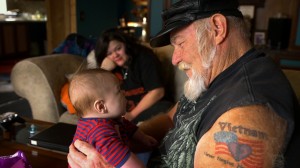
Review: One Night Only
Stray Dog (Debra Granik, USA, 2014, 98 min)
Screening and Q & A with Debra Granik and Ron Hall, UW Cinematheque, 4070 Vilas Hall, Sunday September 28, 7:00 pm»
“I ain’t gonna hurt you little fella, I need you,” Ron Hall tells a bee pollinating flowers in his garden in the last line of Debra Granik’s documentary Stray Dog. To cut to black after this line might at first seem abrupt, but audiences will quickly realize that this is a perfect ending that recapitulates one of the central themes in Stray Dog: we need each other, and we can provide for each other in many different ways.
Ron Hall appeared in Granik’s fiction feature Winter’s Bone (Jennifer Lawrence’s breakthrough film), but Stray Dog is an observational documentary following Hall’s life as a trailer park owner in rural Missouri. We first meet Ron as he engages with two important communities in his life: bikers and Vietnam veterans. While Ron has a calm, friendly demeanor, we soon see that he is also restless. Like many veterans of war, he remains active in public memorials for his fallen friends while he struggles with the curse of his own memories. The first third of Stray Dog focuses on Ron’s interactions with the veterans’ community, as he finds solace in the disciplined pageantry of public ceremonies while he privately battles nightmares and overwhelming feelings of guilt. He participates in a “Run to the Wall,” a biker caravan to the Vietnam Veterans Memorial in Washington D.C. Along the way he talks to veterans, young and old, about the experiences and memories that only they can understand.
Luckily, Ron also has a a tremendously supportive and loving wife, Alicia, a Mexican immigrant who has made many adjustments to live with Ron in Missouri. Their commitment to each other includes learning each other’s native languages, adding another dimension to the theme of support for each other in the film. Alicia seems completely oblivious to American history (she asks about the figures in a Civil War chess set) and current American conflicts (she has to ask Ron if America is at war currently, and with whom). But she thoroughly understands Ron, and provides some of the most insightful observations about him of anyone we meet in the film. Together they create a fascinating extended family: Ron has a grown daughter and a pregnant granddaughter; Alicia has two 19-year-old sons in Mexico. Alicia accompanies Ron on the Run to the Wall, even though we’re never quite sure about her enthusiasm for the biker lifestyle.
 The sequence at the Vietnam Veterans Memorial is admirable because instead of milking the moment for maximum affect, it is shockingly efficient and respectfully moves on when Granik’s point has been made. Unlike similar sequences in other documentaries and fiction films, the sequence takes place at night, giving the scene a distinct visual style as participants use candles and flashlights to search and examine the wall. But perhaps most importantly it appears at the end of the first act, not as the climax for the entire film. As crucial as his experience as a veteran and a biker has been for Ron, there are many more equally interesting dimensions to his life, and Stray Dog provides a look at several of them: husband, father, grandfather (and eventually great-grandfather), business owner, step-father to young men, neighbor, colleague, and friend. In all of these roles, we see Ron help others and receive help as he builds a unique community of family and friends.
The sequence at the Vietnam Veterans Memorial is admirable because instead of milking the moment for maximum affect, it is shockingly efficient and respectfully moves on when Granik’s point has been made. Unlike similar sequences in other documentaries and fiction films, the sequence takes place at night, giving the scene a distinct visual style as participants use candles and flashlights to search and examine the wall. But perhaps most importantly it appears at the end of the first act, not as the climax for the entire film. As crucial as his experience as a veteran and a biker has been for Ron, there are many more equally interesting dimensions to his life, and Stray Dog provides a look at several of them: husband, father, grandfather (and eventually great-grandfather), business owner, step-father to young men, neighbor, colleague, and friend. In all of these roles, we see Ron help others and receive help as he builds a unique community of family and friends.
Stray Dog provides an interesting contrast to the filmmaking strategies in Walking the Camino, which I recently reviewed. Camino tries to tell you why walking the Camino pilgrimage is important, but you never effectively relate to how the pilgrimage has changed the pilgrims. Stray Dog, on the other hand, doesn’t try to tell you anything directly, instead it shows you the impact that the participants have on each other, which immediately engages us. Granik’s points are made by selecting, ordering, and juxtaposing moments in which the participants reveal a part of themselves without trying to make any particular point themselves (like Ron’s last line, quoted above). By focusing on Ron Hall’s experience, Stray Dog ends up being “about” a lot of topics: veteran’s affairs and welfare; post-traumatic stress disorder; aging; changing definitions of “family” and “masculinity”; immigration, language and, well, the American Dream. I learned more about the significance of these topics in short scenes in Stray Dog than I learned about the significance of the Camino pilgrimage in the full running time of Walking the Camino.
Granik’s visual style, sound design, and structure is far more sophisticated as well. Many scenes have a staccato visual rhythm with jump cuts that never seem jarring because of the sound mix which provides a smooth flow with sound overlaps and bridges. Only in the middle third does the film seem to lose a bit of its focus, when an episodic sequence of scenes doesn’t carry the same narrative momentum of the Run to the Wall. But that momentum is restored with the introduction of Alicia’s 19-year-old twins, Angel and Jesus, as they secure legal status to move from Mexico to join Ron and Alicia in Missouri. All along the way, Granik and her crew capture some vivid images of life in the heartland. One of my favorites: a short woman standing on a chair so that she can dance with her tall partner. Granik’s storytelling sense can be as strong in individual shots as it is in edited scenes.
As privileged as the UW Cinematheque audience will be to have a Q & A session with Granik after the film (you can read Rob Thomas’s Capitol Times interview with Granik here), they will be equally privileged to have an opportunity to ask Ron Hall questions as well. Once the knucklehead who is sure to ask Granik what Jennifer Lawrence is really like is out of the way, I would anticipate an equal amount of questions, if not more, for Hall. After viewing Stray Dog, the conversation will likely feel like one with a friend.